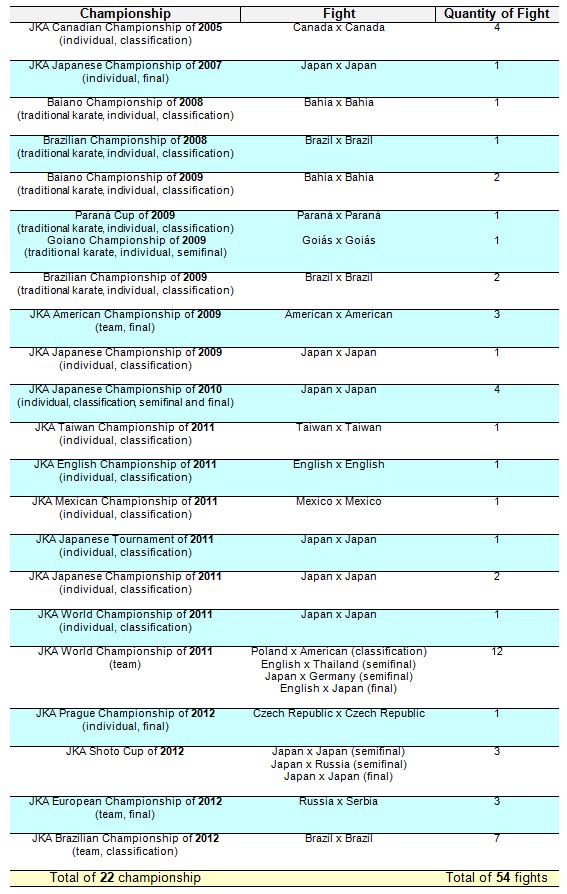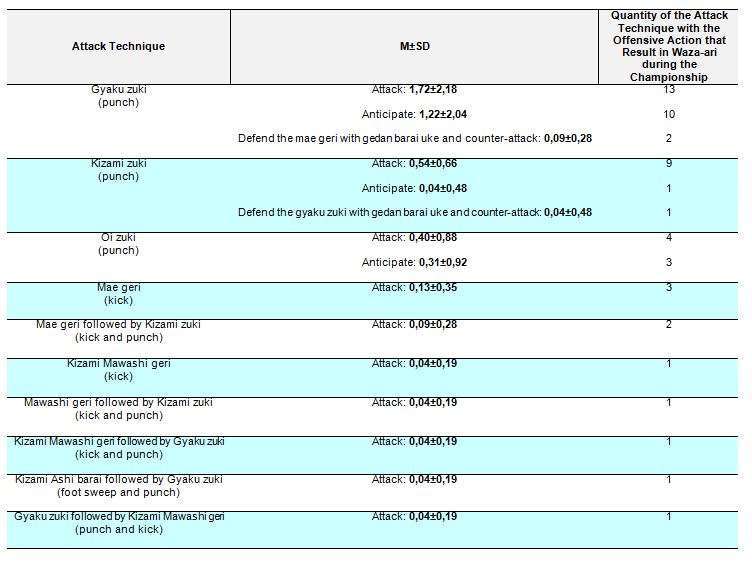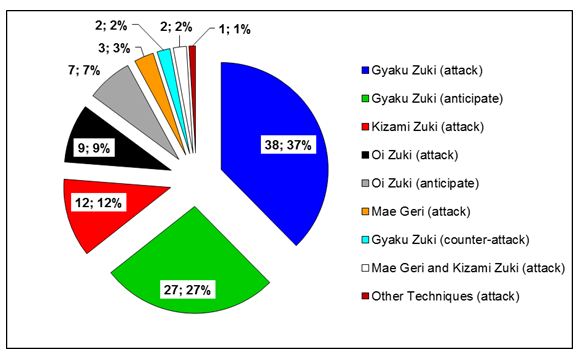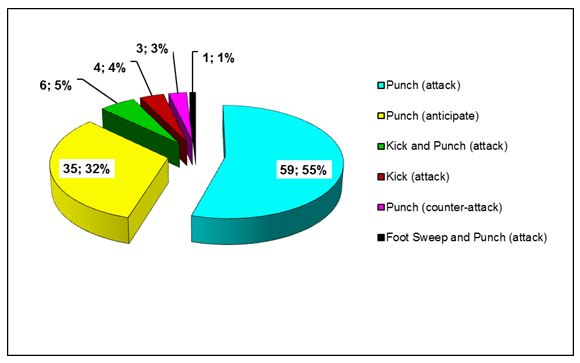
|
|||
|---|---|---|---|
|
|
Shotokan karate: score of the techniques during the female kumite of competition Karatê shotokan: pontos dos golpes durante o kumite de competição feminino Karate shotokan: los puntos de los golpes durante el kumite de competición femenino |
|
|
|
Master in Science of the Human Motricity by the Castelo Branco University, RJ (Brazil) |
Nelson Kautzner Marques Junior |
|
|
|
Abstract The objective of the study was to determine the offensive action (attack, anticipate and counter-attack) and the attack technique that causes ippon and waza-ari during the female kumite. This study used a quantitative research for identify the offensive action and the attack technique that causes ippon and waza-ari during the female kumite. Were selected on the Internet several championship of shotokan karate about the female kumite. The fights were of the JKA and of the Traditional Karate-do. The scout from Marques Junior [7] was used to the notes the offensive action and the attack techniques that causes point. The female kumite during 54 fights in 22 championship practiced waza-ari. The female karatekas practiced with more often the attack (63%) and after the anticipation (34%). The most frequent waza-ari was of gyaku zuki during the attack (37%). The karateka practiced points with others techniques: kizami zuki, oi zuki, mae geri, mawashi geri and kizami ashi barai followed by gyaku zuki. Female karateka practiced more point with punch than the kick. The punch with attack action was more practiced in this study (55%). In conclusion, female karateka practiced waza-ari with foot sweep and punch, punch and kick. Keywords: Karate. Fight. Kumite. Sport. Female karate.
|
|||
|
|
EFDeportes.com, Revista Digital. Buenos Aires, Año 17, Nº 174, Noviembre de 2012. http://www.efdeportes.com/ |
|
|
1 / 1
Introduction
Shotokan karate is a fight with punches, kicks and defenses1. The offensive techniques during the shiai kumite (fight of competition) are with light contact on the trunk of the female karateka2. The fight of the karate occurs in an area of 8x8 meters during 1 minute and 30 seconds to 2 minutes3.
The championship of the male kumite is researched in the literature of the karate4. The punches of the male kumite with higher index score are the gyaku zuki, the kizami zuki and the oi zuki5 [4] and the kicks with most point in male karate are the mae geri and the mawashi geri6.
However, the studies about o female kumite with attack techniques that causes most points to the literature this sport not researched. The references of the karate not researched the actions during the attack of the female karateka. Nakayama7 informed that the karateka practices during the fight three actions for causes the point: attacking the opponent, anticipate the opponent`s attack and defend the offensive techniques of the opponent and counter-attack with an attack technique.
The objective of the study was to determine the offensive action (attack, anticipate and counter-attack) and the attack technique that causes ippon and waza-ari during the female kumite.
Material and methods
Subjects and procedures
This study used a quantitative research8 for identify the offensive action (attack, anticipate and counter-attack) and the attack technique that causes ippon (perfect technique of attack) and waza-ari (efficient technique of attack) during the female kumite. Were selected on the Internet several championship of shotokan karate about the female kumite. The fights were of the JKA (Japan Karate Association) and of the Traditional Karate-do. The key words used to select the fighting were as follows: karatê-dô tradicional feminino, karatê JKA feminino, karatê-dô tradicional feminino em equipe, karate JKA feminino em equipe, traditional karate female, JKA karate female, traditional karate female team kumite, JKA karate female team kumite, shotokan karate female team kumite, JKA shotokan karate female team kumite and European karate female.
The scout from Marques Junior3 was used to the notes the offensive action and the attack techniques that causes point. The fighting used in the study is shown in Table 1.
Table 1. Fights of the female kumite

Statistical analysis
Results are expressed as mean (M), standard deviation (SD), percentage and total.
Results and discussion
Table 2 presents the offensive action of the female kumite.
Table 2. Types of offensive actions

The Figure 1 presents the total ant percentage of the three types of offensive actions during the female kumite.

Figure 1. Offensive action of the female karateka of the shotokan style
Offensive action of the female kumite was equal to the studies of male kumite3,9. The female karatekas practiced with more often the attack and after the anticipation.
Table 3 presents attack technique with the offensive action that result in waza-ari.
Table 3. Types of attack with waza-ari

The Figure 2 presents the total ant percentage of the attack techniques with the offensive actions that result in waza-ari.

Figure 2. Attack techniques with the offensive actions that result in waza-ari
In 54 fights, the female kumite not practiced ippon. The female kumite during 54 fights in 22 championship practiced waza-ari.
The most frequent waza-ari was of gyaku zuki during the attack (total of 38, 37%) and during the anticipation (total of 27, 27%). This result was identical to of Villani and Distaso10, the gyaku zuki practiced more point in male kumite.
The gyaku zuki causes many points during the female kumite because has precision for to hit the opponent6, is the punch faster (Velocity: gyaku zuki with 9,2 m/s, kizami zuki with 7,1 m/s and oi zuki with 5,83 m/s) and with arms the karateka has more ability to make the point11.
The mae geri was the kick with more point during the female kumite. The mawashi geri was the second in the practice of the waza-ari. This result was identical to of Marques Junior6, the mae geri and the mawashi geri practiced more point in male kumite. However, female karateka practiced more point with punch than the kick. This is accordance with Roschel et alii12, approximately 80% of the points during the male kumite are with punch. The punch with attack action was more practiced in this study (total of 59, 55%). The Figure 2 illustrates these findings.

Figure 2. Attack with the offensive actions that result in waza-ari
Conclusion
The female karateka practiced during the kumite points (waza-ari) with the gyaku zuki, the kizami zuki, the oi zuki, the mae geri, the mawashi geri and the kizami ashi barai followed by gyaku zuki. The offensive actions more practiced to were the attack and anticipation.
The karate training needs to be practiced with predominance of the attack techniques and of the offensive actions that cause more points during the female kumite. During the training of the kihon, of the kihon ippon kumite, of the gohon kumite and of the kumite, the coach needs to prescribe the gyaku zuki, the kizami, zuki, the oi zuki, the mae geri, the mawashi geri and the kizami ashi barai followed by gyaku zuki with the attack action and with the anticipation action for the female karateka improve in the championship.
References
-
Halwish A (2011). Kinematics of the mawashi shoudan kick as a parameter of designing a training program for karate juniors. World J Sport Sci 5(4):237-244.
-
Iide, K et alii (2008). Physiological responses of simulated karate sparring matches in young men and boys. J Strength Cond Res 22(3):839-844.
-
Marques Junior N (2012). Pontos dos golpes durante o kumitê de competição do karatê shotokan masculino. Lecturas: Educ Fís Deportes, 17(169), 1-7. http://www.efdeportes.com/efd169/pontos-dos-golpes-durante-o-kumite.htm
-
Laird P, McLeod K. (2009). Notational analysis of scoring techniques in competitive men`s karate. Int J Perform Analysis Sport 9(2):171-87.
-
Koropavanovski N, Dopsay M, Jovanovic S (2008). Characteristics of pointing actions of top male competitors in karate at World and European level. Braz J Biomotr 2(4):241-51.
-
Marques Junior N (2011). Karatê shotokan: pontos dos golpes durante o kumitê de competição masculino. Ulbra Mov 2(1):1-15.
-
Nakayama M (2012). O melhor do karatê – kumite 1. vol. 3. 7ª ed. São Paulo: Cultrix.
-
Thomas J, Nelson J (2002). Métodos de pesquisa em atividade física. 3ª ed. Porto Alegre: Artmed.
-
Koropavanovski N, Jovanovic S (2007). Model characteristics of combat at elite male karate competitors. Serbian J Sports Sci 1(3):97-115.
-
Villani R, Distaso M (2004). Technical-tactical evolution of the international competition of karate. 9th Congress of the ECSS. Clermont-Ferrand, France.
-
Marques Junior, N (2012). Velocidade do soco e do chute do karatê: uma meta-análise. Lecturas: Educ Fís Deportes, 17(169):1-7. http://www.efdeportes.com/efd169/velocidade-do-soco-do-karate.htm
-
Roschel R et alii (2009). Associations between neuromuscular tests and kumite performance on the Brazilian Karate National Team. J Sports Sci Med 8(3):20-24.
Another articles in English
 |

Búsqueda personalizada
|
|---|---|
|
EFDeportes.com, Revista
Digital · Año 17 · N° 174 | Buenos Aires,
Noviembre de 2012 |
|